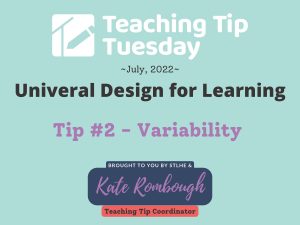
What is Variability in UDL Instruction?
The UDL guidelines are: 1) Multiple Means of Engagement, 2) Multiple Means of Representation, and 3) Multiple Means of Action and Expression. To learn more about the science behind the framework visit the cast.org website.
Variability in Instruction involves using a variety of instructional formats and methods. Increase opportunities to learn by presenting information in different formats throughout the course (this relates to UDL Guideline #2 from above).
Why Should I Use a Variety of Formats?
Use a variety of strategies and formats to engage students. Student engagement is linked to a number of positive learning outcomes such as motivation and academic achievement (Gunuc, 2014; Kuh et al., 2008). Throughout the course, use various means of engaging students.
How Can I Do This?
- Use readings, images, graphics, tables, graphs, videos, timelines, or simulations, as appropriate.
- In addition to lecturing, include discussions, peer learning activities, problem-solving activities, and other forms of instruction that fit your content/discipline.
- Address students by name. In large classes, strive to learn as many students’ names as possible and let students know that you are trying to learn their names. Even if you forget some names, students will likely appreciate that you are making an effort.
- Provide opportunities to practice the skills being taught (e.g., self-assessment activities).
- Model the process involved in an assigned task (e.g., show students the steps you would take if you were completing the assigned task).
- Avoid giving unnecessary grades for mere attendance or penalizing students for missing class. This is especially important for students who miss class as a result of a disability, as communicated by AccessAbility Services. Even in courses in which attendance is essential due to workshop or group activities, explore ways to have students present in alternative ways (e.g. collaborative online apps).
- Periodically prompt students to draw connections between the material and the world around them.
- Avoid overusing one type of learning activity (e.g., small group discussions); although that method might engage some students, it could pose barriers to others.
- Where feasible, offer some choice. Choice enables students to deepen their engagement with the course material and allows students to use their strengths to more effectively show what they know.
- Let students know that you care about how they are doing.
…New tip next week!
Attribution Statement: This resource was adapted from
What is Universal Design? | Centre for Teaching Excellence, University of Waterloo. (2019). Retrieved 7 July 2022, from https://uwaterloo.ca/centre-for-teaching-excellence/teaching-resources/teaching-tips/planning-courses-and-assignments/what-universal-design CC-BY-SA 4.0
Universal Design: Instructional Strategies | Centre for Teaching Excellence, University of Waterloo. (2019). Retrieved 7 July 2022, from https://uwaterloo.ca/centre-for-teaching-excellence/teaching-resources/teaching-tips/planning-courses-and-assignments/universal-design-instructional-strategies CC-BY-SA 4.0
